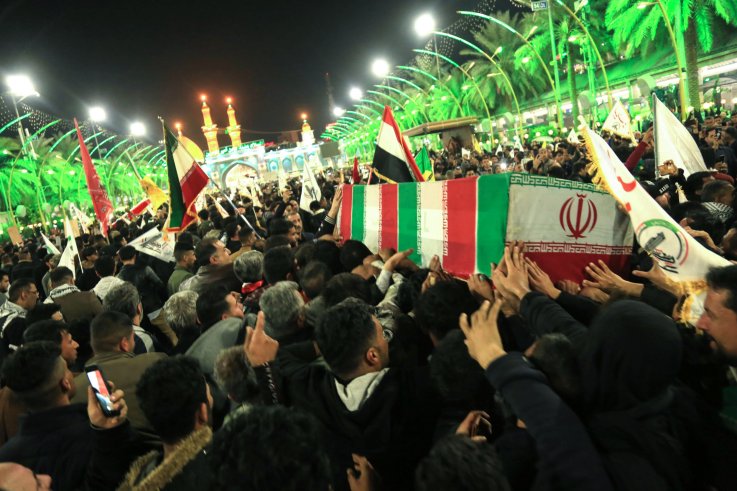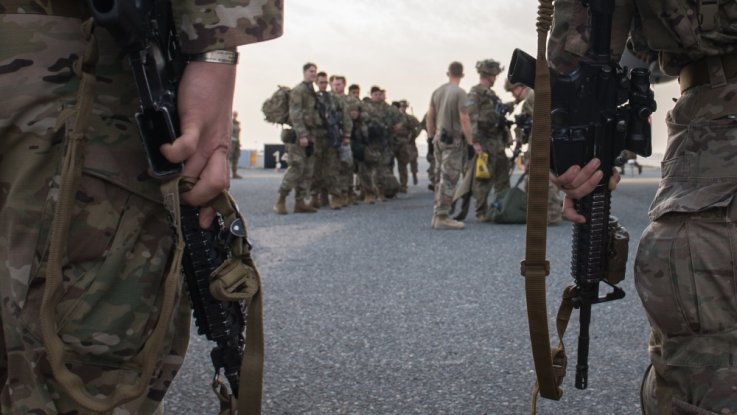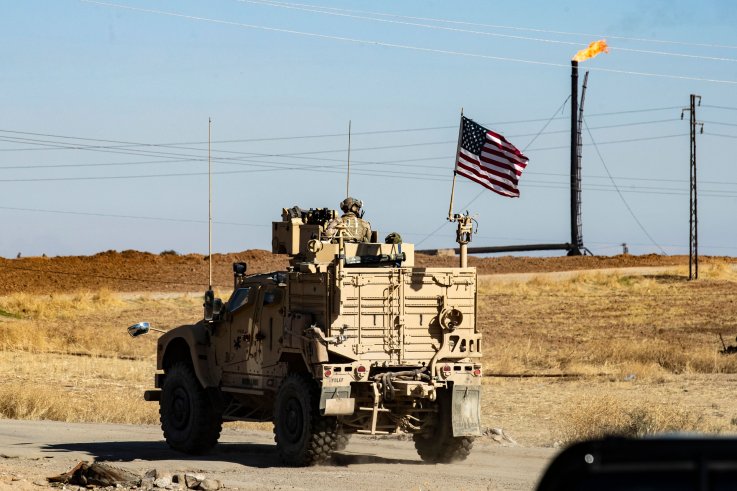
By Tim O’Connor
From Newsweek | Original Article
The United States has tens of thousands of troops deployed across the Middle East and Afghanistan, many of them in nations near Iran at a time when the two countries were nearing an all-out conflict.
President Donald Trump’s decision to kill one of Iran’s most senior figures, Revolutionary Guard Quds Force commander Major General Qassem Soleimani, and Iraq militia leader Abu Mahadi al-Muhandis in Baghdad has sent shockwaves throughout the region. The administration argued that the senior Iranian military figure had “plans to attack” U.S. citizens and interests, but the move has raised questions about Washington’s relationships with host countries. It has also led Baghdad’s parliament to vote to expel American troops from within its borders.
In a statement sent to Newsweek by the State Department, spokesperson Morgan Ortagus said the Trump administration “is disappointed by the action.”
“While we await further clarification on the legal nature and impact of today’s resolution, we strongly urge Iraqi leaders to reconsider the importance of the ongoing economic and security relationship between the two countries and the continued presence of the Global Coalition to Defeat ISIS,” Ortagus said. “We believe it is in the shared interests of the United States and Iraq to continue fighting ISIS together. This administration remains committed to a sovereign, stable, and prosperous Iraq.” Ads by scrollerads.com
Amid escalating tensions, the U.S. sent additional forces to the region despite Trump’s earlier pushes to withdraw personnel and a letter containing Pentagon plans to leave Iraq, which turned out to be a “draft” sent to Baghdad by “mistake.”
Afghanistan
The U.S. intervened militarily in Afghanistan weeks after the 9/11 attacks that killed nearly 3,000 people and set the stage for the “War on Terror” that has since dominated the Pentagon’s presence in the nearby Middle East. Although the U.S. managed to overthrow the Taliban’s government, the group has remained a powerful insurgent force that even after 18 years of war has managed to steadily retake regions.
The Trump administration has engaged in successive rounds of diplomacy with the militant group’s diplomats in the Qatari capital of Doha in hopes of striking a peace agreement that would foster direct Taliban-Afghan government negotiations. Newsweek reported in August that the U.S. considered reducing its roughly 14,000 troops in Afghanistan by more than half, leaving roughly 6,000 behind—although talks fell apart the following month amid continued violence.
A day after the dialogue restarted in December, the Taliban claimed an attack outside Bagram Airfield, the largest U.S. military base in the country with the most troops on this list. Talks, however, officially remain on the table. Meanwhile, Iran?—which borders Afghanistan?—and other countries such as China, Russia and India have also sought to play a role in a potential peace process.
Bahrain
The U.S. has maintained a military presence in the small island state of Bahrain since World War II, when troops were sent to support United Kingdom’s forces after they came under Italian air raids. Today, Naval Support Activity Bahrain, located in the capital of Manama, serves as the headquarters for both the Fifth Fleet and U.S. Naval Forces Central Command (CENTCOM). Up to 7,000 U.S. troops are stationed throughout the country.
The Sunni Muslim monarchy, which has led Bahrain for centuries, has expressed concern over Iran’s potential influence over the country’s mostly Shiite Muslim population and was among the first countries to join a U.S.-led naval coalition established last year to patrol the nearby Persian Gulf. Ali Saeedi, Iranian supreme leader’s representative to the Revolutionary Guard, told the official Islamic Republic News Agency on Saturday that he did not expect a war between the U.S. and Iran, but that the Islamic Republic’s armed forces had missiles aimed at 35 U.S. bases in the region, “the closest being in Bahrain.”
Military officials told Newsweek on Friday that U.S. Patriot surface-to-air missile defense systems had been placed on alert in Bahrain.
Iraq
The U.S. military imposed no-fly zones over Iraq following the 1991 Gulf War, and the Pentagon established a ground presence there in the 2003 invasion that overthrew then-Iraqi President Saddam Hussein. After battling with Sunni Muslim militants and clashing with Shiite Muslim militias as well, the U.S. withdrew in 2011 but redeployed thousands of troops in 2014 following the partial takeover of the Islamic State militant group (ISIS).
The U.S. and Iran both supported Iraq’s battle against the jihadi group, but ISIS’ defeat opened the door for new international tensions as the U.S. waged a “maximum pressure” campaign against neighboring Iran. Unclaimed rocket attacks targeting military bases that were blamed by Washington on Iran-backed, Shiite Muslim fighters, and last week’s retaliatory U.S. strikes, threatened to relegate the country to a battleground between two foreign powers that Baghdad considered to be partners.
While many Iraqis, who’ve protested their government for months, have expressed opposition to Iran’s influence within their country, massive crowds also turned out to mourn Soleimani and Muhandis after they were killed in the U.S. military operation near Baghdad International Airport late last week. Trump has warned he would sanction Iraq if it executes its plans to expel 6,000 American troops.

Jordan
Jordan has for decades been a close Western partner and is one of only two Arab countries to have reached a peace agreement with Israel. The other is Egypt. The kingdom helped to facilitate the U.S.-led program to support insurgents in neighboring Syria, although this support was mainly limited to the Maghawir al-Thawra group active in a U.S. desert outpost across the border.
Jordan hosts about 3,000 troops as part of the anti-ISIS mission and directly borders Iraq. However, it has expressed caution about growing regional instability.
Kuwait
After defeating invading Iraqi forces in 1991, the U.S. entered into a military agreement with Kuwait, which has served as one of the Pentagon’s most important Middle East hubs since then. In October, U.S. troops and armored vehicles were redeployed from Kuwait to eastern Syria to shore up control over oil resources in the region after Trump ordered a partial withdrawal from other parts of the war-torn country.
Amid flaring tensions between the U.S. and Iran, Kuwait has reportedly begun to receive most of the additional 3,000 Pentagon personnel being sent to the Middle East. The country now hosts about 13,000 U.S. troops, tying it with Qatar.
Kuwait has continued to maintain formal relations with Iran despite the Islamic Republic’s troubled ties with the U.S. and Arab countries across the Persian Gulf. Kuwait on Sunday denied that the U.S. drone that assassinated Soleimani originated from its territory.
Oman
Oman has diplomatic ties with Iran and has, at times, served as a backchannel between the U.S. and Iran. The sultanate has strived for neutrality in most regional affairs, but it has allowed the U.S. access to its military facilities since 1980, the same year Iraq invaded Iran and launched a bloody eight-year conflict that was accompanied by so-called “tanker wars,” during which the U.S. intervened directly.
Oman holds a strategic position near the Strait of Hormuz, the world’s most important seaborne oil route, and today hosts about 606 U.S. troops. Unclaimed attacks blamed by the U.S. on Iran struck vessels carrying oil in the Gulf of Oman last spring, reigniting unrest near the strategic oil routes of the Persian Gulf region.
Iran has denied any role in these attacks, which along with the Revolutionary Guards’ downing of a U.S. Navy drone in June, were used to justify the Trump administration’s International Maritime Security Construct, so far joined by Albania, Australia, Bahrain, Saudi Arabia, the United Arab Emirates and the U.K.
Iran has invited regional countries, including Oman, to form a Coalition for HOPE, or Hormuz Peace Endeavor.

Qatar
Qatar is home to the largest U.S. military base in the Middle East, Al Udeid Air Base, which was built after the first Gulf War. The massive installation today hosts an estimated 13,000 troops, along with a forward base of CENTCOM, and is the headquarters of U.S. Air Forces CENTCOM.
Qatar’s ongoing relations with Iran, along with its support for the Muslim Brotherhood organization were among the reasons cited by neighboring Saudi Arabia for its decision to announce a total boycott on the tiny peninsular country in 2017. Bahrain, Egypt and the UAE were among the nations that cut ties with Qatar in solidarity.
The U.S. has officially remained neutral in the crisis, although Trump has repeated some Saudi allegations regarding Qatar’s suspected ties to terrorism. Qatar also hosts a Turkish military base established in 2017.
Saudi Arabia
Saudi Arabia received large numbers of U.S. military personnel during the Gulf War and a number of them remained even after the conflict, a move that proved controversial among Muslims in the region who saw this as disrespectful to Islam’s two holiest sites, Mecca and Medina, which are located within the kingdom. U.S. military presence in Saudi Arabia was cited by Al-Qaeda for its attacks on U.S. embassies in East Africa in 1998, the USS Cole bombing in 2000 and 9/11 in 2001.
The U.S. withdrew personnel from Saudi Arabia in late April 2003, about a month before invading Iraq. The first U.S. troops returned during this past summer as Trump sought to bolster the Pentagon’s positions against what his administration perceived to be Iranian aggression in the Persian Gulf region.
Saudi Arabia and Iran have long been engaged in a regional rivalry of influence and severed ties in early 2016 after Iranian protesters burned Riyadh’s embassy in Tehran in response to the kingdom’s execution of a prominent Shiite Muslim cleric. Saudi Arabia is believed to now host up to 3,000 U.S. troops and the Pentagon has sent additional missile defense capabilities there since oil facilities were targeted in a September missile and drone attack claimed by Yemen’s Ansar Allah, or Houthi, Zaidi Shiite Muslim movement but blamed by Riyadh and Washington on Tehran.
Syria
The U.S. supported the 2011 rebel and jihadi uprising against the Syrian government, but did not directly intervene until launching its anti-ISIS mission in June 2014. The move came shortly after Tehran, which had already been assisting Damascus, boosted backing for its closest, longtime Arab ally.
As in Iraq, Iran’s efforts in Syria were largely overseen by Soleimani himself. While the U.S. and Iran were both opposed to ISIS, they backed different factions, with the Pentagon later partnering with the majority-Kurdish Syrian Democratic Forces as Russia joined Iran in supporting the Syrian government.
Trump has for years expressed a desire to pull troops out of Syria, which regards the U.S. and Turkey as occupying forces and has repeatedly called for both to leave immediately. While Ankara is opposed to the government in Damascus, it sees the U.S.-backed Kurdish fighters as a top threat. A Turkish-backed, cross-border assault in October led Trump to pull out forces, leaving about 800 troops, mostly in the oil-rich east.

Turkey
Though outside of the CENTCOM realm of operations, Turkey hosts about 2,500 troops at the Incirlik Air Base, which serves the U.S. European Command and houses nuclear weapons. Turkey has been a member of the U.S.-led NATO Western military alliance since 1952, but its war on Pentagon-backed Kurdish fighters in Syria and growing proximity to Moscow has sometimes left it at odds with Washington.
Turkey opposes U.S. sanctions on Iran and both Middle Eastern powers have joined Russia in engaging in a trilateral peace process in Syria.
United Arab Emirates
The UAE hosts roughly 5,000 U.S. troops on the frontlines of growing tensions with Iran. Last year’s tanker attacks occurred in Emirati waters and the U.S. drone downed by Iran last June originated from the UAE. However, Abu Dhabi has appeared to slightly soften its stance toward Tehran in the months following, hosting bilateral maritime cooperation talks and calling for regional diplomacy.
The UAE has also stepped down its involvement in the Saudi-led war against the Houthi movement in Yemen, a military campaign that U.S. lawmakers have called on the Trump administration to abandon over human rights concerns. Once a supporter of efforts to overthrow the Syrian government, Abu Dhabi has since cast its support for Damascus.
The U.S. and the UAE signed their first defense cooperation agreement in 1994 and continue to work together closely, although Abu Dhabi, like many other regional powers, have also sought to develop relations with emerging regional forces, such as Russia and China.
